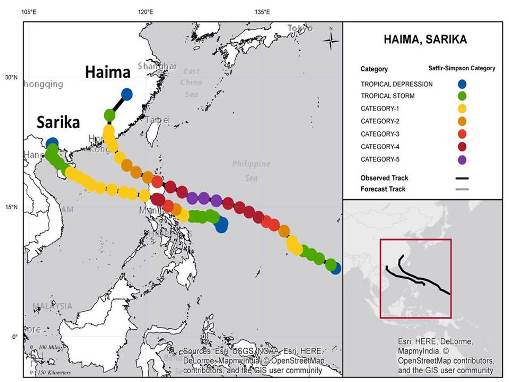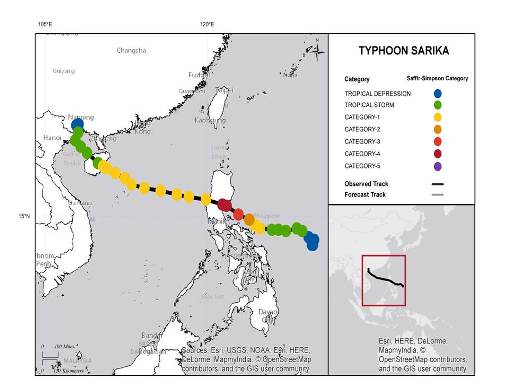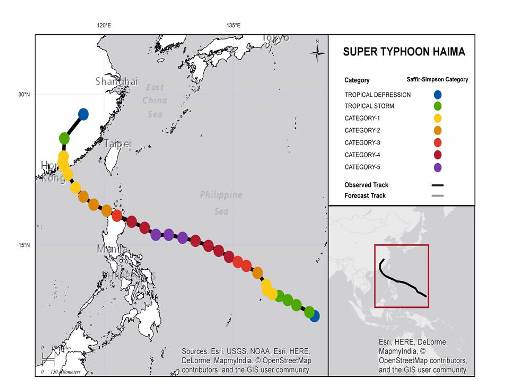

In the Northwest Pacific Basin, Typhoon Sarika and Super Typhoon Haima affected areas of the Philippines, Vietnam and Mainland China in 2016. Both typhoons made landfall in the northern Philippines within a week, as a Category 4 on the Saffir-Simpson scale. Reported impacts in the northern Philippines have been especially severe, with reports of moderate to complete damage over areas of northern Luzon. Damage from wind, flooding and mudslides have been reported, together with reports of downed trees and powerlines.
In Mainland China, at least 2,700 homes have been damaged according to media reports. Heavy rainfall and strong winds have rendered downed trees and powerlines over areas of Fujian and Guangdong Provinces, with power outages affecting well over two million. Considerable crop damage has also been reported for affected areas.

Track and position reports. Source: Guy Carpenter, Joint Typhoon Warning Center.

Sarika track and position reports. Source: Guy Carpenter, Joint Typhoon Warning Center.

Haima track and position reports. Source: Guy Carpenter, Joint Typhoon Warning Center.
Hazard data illustrated in the CAT-i map was taken from GC AdvantagePoint®, Guy Carpenter’s web-based risk management platform. GC AdvantagePoint users can view impacted areas on any map as well as see how their portfolios were affected. Please contact your broker or cat modeling analyst for further information.
At least 13 fatalities have been reported and our first thoughts and concerns are with those lost and directly affected by this event.
Meteorological Discussion
Typhoon Sarika
In the West Pacific Basin, Typhoon Sarika was first classified as a tropical depression by the Joint Typhoon Warning Center (JTWC) at 12 UTC, October 12.
The feature was upgraded to tropical storm strength 24 hours later at 12 UTC, October 13, and then to typhoon status by 18 UTC, October 14. The typhoon then underwent a period of rapid intensification to carry one-minute sustained winds of 220 kilometers per hour (135 mph) by 18 UTC, October 15, a Category 4 on the Saffir-Simpson scale, shortly before making landfall in Luzon in the Philippines. Typhoon Sarika made landfall in Luzon early morning of Sunday, October 16 (local time).
After clearing Luzon with one-minute sustained winds of 145 kilometers per hour (90 mph), Sarika continued to degrade while approaching the mainland of Southeast Asia. After making landfall in Hainan just after 00 UTC, October 18, Sarika weakened to tropical storm status before making final landfall around 00 UTC, October 19, near the border of Vietnam and Mainland China.
Super Typhoon Haima
Typhoon Haima was first classified by the JTWC as a tropical depression at 18 UTC, October 14, and upgraded to tropical storm status six hours later. Haima was then upgraded to typhoon status only a short time later at 00 UTC, October 16. Haima then underwent a period of rapid intensification while approaching the Philippines, to carry one-minute sustained winds of 185 kilometers per hour (115 mph) by 00 UTC, October 17. Haima was upgraded to super typhoon status at 06 UTC, October 18, before reaching its peak strength. At 18 UTC, October 18, Super Typhoon Haima carried one-minute sustained winds of 265 kilometers per hour (165 mph), a Category 5 on the Saffir-Simpson scale, with a minimum central pressure of 900 hPa (mb) reported by the Japan Meteorological Agency. Haima continued to approach the Philippines on a west-northwesterly course.
Haima then moved into the Philippines, over northern Luzon, about 350 kilometers (215 miles) north of Manila. At 12 UTC, October 19 (prior to landfall), Haima carried one-minute sustained winds of about 225 kilometers per hour (140 mph) according to the JTWC. Unofficial wind gusts of up to 315 kilometers per hour (190 mph) were reported. Unofficial rainfall amounts of 361 millimeters (14 inches) were reported in Baguio City. Tuguegarao City reported unofficial rainfall amounts of 245 millimeters (9.65 inches).
The typhoon experienced severe disruption while crossing Luzon due to topography and land interaction. The storm cleared Luzon around 00 UTC, October 20, to then move into the South China Sea while approaching Mainland China.
Media reports indicate that Haima then made landfall in Mainland China, between Hong Kong and Shantou. Just prior to landfall, at 00 UTC, October 21, the JTWC reported one-minute sustained winds of around 145 kilometers per hour (90 mph), a Category 1 on the Saffir-Simpson scale. Media reports indicate that the western eyewall of the typhoon came close to Hong Kong during landfall. The typhoon then weakened to eventually dissipate over Mainland China. Wind gusts of up to 105 kilometers per hour (65 mph) were reported along with heavy rainfall. The area had been previously affected by monsoon rains to amplify the flood threat in Hong Kong and surrounding areas.
Super Typhoon Haima is the strongest typhoon to affect the Philippines since Super Typhoon Haiyan (2013).
Impacts
Philippines
Media reports indicate that significant impacts due to wind, flooding and mudslides were rendered by Haima in northern Luzon, including several farming and mountain communities. At least 13 fatalities were reported along with another missing. Reports indicate that tens of thousands have lost their homes. Flooding and landslides were reported, with significant flood impacts to farming villages in Bataan and Pampanga provinces, where nearly 40,000 were forced to seek refuge. Reports indicate that locations in Isabela Province were severely affected, with impacts to include a mudslide that killed two. Media reports indicate that the Province of Cagayan, with a population of 600,000, also suffered widespread and significant impacts with potential complete loss of power. Survivors have suffered very difficult conditions in some areas with some living in improvised shelters. Aid has been rendered to at least 50,000 people in affected areas.
Communication lines were disrupted, with reported disruption to cell service. Major rice producing provinces were also affected, and agricultural impacts were rendered to rice, corn and vegetables due to inundated crops. The City of Manila experienced moderate winds and some rainfall, but without significant impacts.
Before Haima crossed the Philippines, Typhoon Sarika left at least two dead and three missing in the Philippines according to media reports. Power outages were widespread and at least 15,000 were forced to evacuate. Downed trees and powerlines, with variable structural damage due to wind and flooding were reported.
Mainland China
Typhoon Haima affected southern China following a period of intense monsoon rains, amplifying the flood threat from Haima's rainfall. Reports indicate damage to at least 2,700 homes. The typhoon has also rendered significant crop damage. Downed trees and powerlines over widespread areas have also been reported. Power outages have affected at least 2.12 million households, according to media reports.
Reports indicate that damage to Hong Kong was not especially severe. More than 700 flights in and out of Hong Kong were cancelled or delayed and ferry services were cancelled. Underground metro services were reduced and surface buses were cancelled. Schools and offices were closed and streets were deserted. The Hong Kong stock exchange was closed on October 21. Waves overran some coastal roads according to media reports.
Sources: Agence France Presse, Reuters, Joint Typhoon Warning Center, Weather Underground, AIR Worldwide, Japan Meteorological Agency, RMS, Xinhua News Agency
Guy Carpenter publishes CAT-i reports for major natural catastrophes worldwide. These reports cover catastrophes including worldwide tropical cyclones, earthquakes, major UK and European floods and any other natural event that is likely to incur a significant loss to the (re)insurance industry. Please email CAT.i@guycarp.com if you wish to be added to the free email distribution list.
Guy Carpenter compiles RISK-i reports for major technological or man-made events worldwide. These reports cover risks to property, transport and life including explosions, fires, crashes, engineering disasters and terrorist attacks that are likely to incur a significant loss to the (re)insurance industry. Please email RISK.i@guycarp.com if you wish to be added to the free email distribution list.